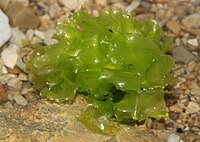
Photo from wikipedia
Alterations of chloroplast membrane lipids might serve as indicators of eco-physiologically induced and plant nutrition-induced changes during plant growth. The change in the degree of fatty acid saturation in the… Click to show full abstract
Alterations of chloroplast membrane lipids might serve as indicators of eco-physiologically induced and plant nutrition-induced changes during plant growth. The change in the degree of fatty acid saturation in the membranes is in particular a strategy of plants to adapt to abiotic stress conditions. Green multi-leaf lettuce plants (Lactuca sativa L.) were subjected to three different sulfur (S) levels. Sulfoquinovosyl diacylglycerol derivatives (SQDG) might be affected by S nutrition. Therefore, the present study was conducted to investigate the impact of S fertilization on the content and composition of individual SQDG. In addition to a change in the SQDG composition, a general change in the total lipid composition of the chloroplast membrane was observed. A significant increase in total SQDG content and doubling of the galactolipid content and significant alterations of individual SQDG were observed at elevated levels of S fertilization. High levels of S supply demonstrated a clear trend of increasing total chloroplast lipid content and concentrations of linolenic acid, in addition to a further decline in palmitic acid. The study opens perspectives on S supply and its crucial role in the build-up of photosynthetic apparatus. Moreover, it emphasizes the role of S-containing compounds, including sulfolipids, in modulating physiological adjustment mechanisms to improve tolerance ability to various abiotic stresses in plants and, consequently, plant food quality.
Journal Title: Plants
Year Published: 2022
Link to full text (if available)
Share on Social Media: Sign Up to like & get
recommendations!